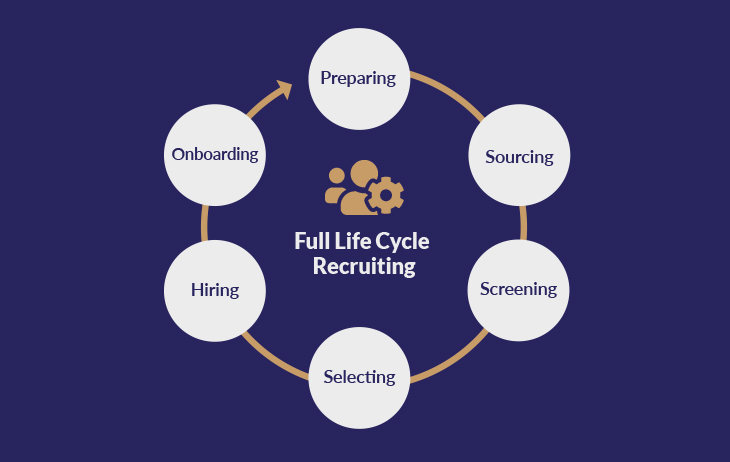Topics: Full Life Cycle Recruiting
Posted on September 26, 2024
Written By QX Global Group

Full cycle recruiting is gaining traction, particularly among small and mid-sized businesses, with 60% of firms opting for a streamlined, end-to-end process to boost hiring efficiency. Research by the Society for Human Resource Management (SHRM) indicates that companies with a full cycle recruiting approach see a 25% reduction in time-to-hire and a 20% improvement in candidate experience . However, only 30% of HR professionals possess the diverse skillset needed to manage the complete recruitment process effectively. As automation tools evolve, integrating technology into full cycle recruiting has become essential, offering a 35% increase in recruiter productivity.
The term “full cycle recruiting” pertains to the complete end-to-end recruitment process. It begins with identifying the need for a new hire to completing the onboarding of the new employee. The process is alternatively called “full life cycle recruiting” or “life cycle recruiting.”
What distinguishes full cycle recruiting from traditional recruiting processes is that it consolidates the various steps of the recruitment process in a single holistic entity.
Larger firms often choose to allocate individual resources to each of the steps of the recruiting process. On the other hand, smaller and mid-sized firms prefer to go for full cycle recruiting.
In small firms, one person may be designated as the full life cycle recruiter and is responsible for the end-to-end recruitment process. In mid-sized firms, a small HR team handles one or more steps of the recruitment process. Large firms have full-fledged HR departments, with individual team members specializing in various stages of the recruitment process.
Organizations may also choose to outsource the entire process or individual steps of life cycle recruitment.
Full life cycle recruiting comprises the following steps.

It is the first step in the life cycle recruiting process. The step includes defining the required employee attributes and writing the job description. Defining employee attributes involves identifying desired professional competencies and behavioral attitudes needed for the job. A well-written job description specifies the nature of the job, explains the firm’s values and goals, and lists the requirements of the role and the proposed compensation. One could use available specialized software tools to write accurate job descriptions.
In the case of talent with niche skills, recruiters conduct online and offline searches to identify candidates who might be passive. Social media sites such as LinkedIn and Facebook are preferred means of identifying potential hires. Recruiters also employ employee referrals and in-house recruiting for talent sourcing.
The screening step of the end-to-end recruitment process whittles down the full list of applicants to a condensed one of probable hires. It involves examining the received resumes to match the job requirements and professional profile of the applicants, followed by a preliminary telephonic discussion. The applicants found most suitable will be shortlisted for further evaluation via an in-person interview.
It involves the identification of the best applicant from the shortlist. Recruiters use a combination of psychometric tests, written tests, task-based tests, and interviews to determine the best person for the job. In some firms, selecting the right person includes background and reference checks of candidates.
Hiring consists of two main activities, namely, negotiations and a final job offer. A good job offer contains a description of the role, nature of employment, start date, working terms, and compensation.
The final step completes and rounds off the recruitment process. A well-designed onboarding process ensures that the new hire fits into the role, meshes seamlessly with the people in the organization, and coheres with the firm’s working culture. An effective onboarding process is a key determinant in the recruitment life cycle, ensuring the new hires fit in the organization.
The 360° recruiting approach affords several benefits.
However, full life cycle recruiting is not without some downsides.
If done well, the end-to-end recruitment helps attract the best available talent, streamlines the recruitment process, enhances candidate experience, reduces immediate turnover, and improves hiring efficiency.
Integration of all the required competencies in a single person is an ideal that is difficult to achieve. QX Global Group has the resources, including the people, databases, technological tools, and knowledge of the processes, which combine to provide you with a single point life cycle recruiting partner.
Originally published Sep 26, 2024 03:09:04, updated Sep 27 2024
Topics: Full Life Cycle Recruiting